Flamethrower SAU Flammpanzer 38 (t), Germany
A proposal to remake a number of existing self-propelled guns with the installation of new weapons appeared in the last months of 1944. According to some sources, the emergence of this proposal was associated with preparations for the Ardennes offensive operation. Taking into account the peculiarities of the landscape and the upcoming battles, the command considered that the troops needed armored vehicles with flamethrowers. There is also a version according to which a new armored vehicle was created for future urban battles, and the period of its creation simply coincided with the preparations for the operation in the Ardennes.
Regardless of the specific prerequisites for the emergence of a new project, it was decided to order the industry to develop a new project for the modernization of existing equipment and then rework a number of existing machines. The development of a new project with the subsequent release of the required machines was entrusted to Böhmisch-Mährische Maschinenfabrik AG (now Českomoravská Kolben-Daněk). Over the next few months, two dozen new cars were required.
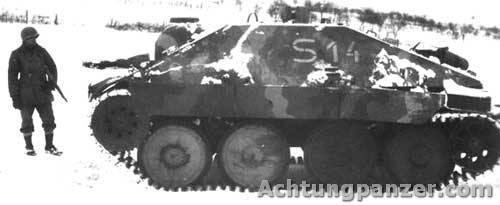
Flamethrower self-propelled gun Flammpanzer 38 (t), which became a trophy of American troops. Photo by Achtungpanzer.com
The anti-tank self-propelled gun Jagdpanzer 38 (t) was chosen as the basis for the Flammpanzer 38 (t) flamethrower tank. This machine a few months earlier entered into mass production and could fully solve the tasks. Relatively new self-propelled guns had sufficient booking and good mobility. By installing new weapons instead of the existing artillery it was proposed to change their tactical role on the battlefield. One of the main features of the new project, as often happened with similar developments, was the use of the minimum possible number of modifications to speed up order fulfillment.
An analysis of the possibilities has shown that when creating a new flamethrower SAU, it will be possible to do without creating new tools and systems. All elements of such a combat vehicle could be created by minimal reworking of existing products. Thus, the flamethrower tank Flammpanzer 38 (t) was supposed to retain the design of the armored hull of the base SAU. He retained a complex shape formed by several inclined armor plates, and had to be assembled by welding from parts of different thicknesses.
The maximum protection characteristics had an upper case part with a thickness of 60 mm, located at an angle 60 ° to the vertical. The bottom frontal sheet had the same thickness, but was installed at a different angle. Also in the design of the frontal part of the body provided armored mask guns. The sides and stern were made of 20-mm sheets, and on the top the crew and units were protected by an 8-mm roof. For some increase in the level of protection of the side projection used 5-mm side screens.
SAU Hetzer had a layout characteristic of the German armored vehicles of the time. Directly under the frontal sheets were placed transmission units, behind which were the crew seats. Management and combat compartments were made in the form of a single manned volume, which occupies the entire front and middle parts of the corps. Feed was given under the engine and other units of the power plant.
The Praga EPA AC 2800 power hp 150 hp was placed in the rear of the car. On self-propelled Jagdpanzer 38 (t) later series, a forced version of this motor was used, capable of producing up to 176 hp. Also, some modifications of the ACS received the engine CH-2DRM with the power 150 hp. Through the multi-disc main clutch and the propeller shaft, the engine torque entered the rest of the transmission units located in the front of the case. It contained a five-speed gearbox, steering mechanism, final drives and side brakes, which were used to rotate the front drive wheels.
As part of the chassis there were four road wheels on each side. The rollers were connected in pairs on their own balancers and equipped with common semi-elliptical springs. Also in the hubs of the balancers provides additional shock absorbers. The drive wheels were located in the front of the hull, guides - in the stern. The self-propelled gun was equipped with a small-track caterpillar with a track width of 350 mm.
In the original configuration, the ACS received an 75-mm anti-tank gun PaK 39. As part of the new flamethrower tank project, it was proposed to remove the gun and install a new system in its place. In addition, stacking for ammunition and other equipment intended for use with a gun was removed from the fighting compartment. The released volume was proposed to be used to accommodate various units of the flamethrower, primarily for the tank with the fire mixture.
As a basis for the self-propelled weaponry, it was decided to use a late-modification Flammenwerfer 41 serial backpack flamethrower, which used ignition with the help of special pyrotechnic cartridges. For installation on a self-propelled chassis, the basic design of the flamethrower had to undergo certain changes. It was necessary to change the layout of the units, to abandon some of the available parts and use the new nodes. In particular, it was possible to increase the volume of fire mixture at times.
On the stored fastenings for the gun, it was proposed to install a flamethrower hose, equipped with a protective tubular casing. The latter could protect the flamethrower pipe from damage, and also did not allow the enemy to identify the flamethrower self-propelled gun at long distances and distinguish it from the Hetzer self-propelled gun with artillery weapons. The possibility of targeting weapons within the horizontal sector on 5 ° to the left and 11 ° to the right. Permissible elevation angles range from -6 ° to + 12 °. Despite the dismantling of the gun, the Sfl.ZF1a sight was retained with a fivefold magnification and a field of view 8 ° wide.
Inside the fighting compartment it was proposed to mount a tank for transporting fire mixture with a volume of 700 l. For comparison, the flamethrower with the product Flammenwerfer 41 could take with him only 7 l mixture, which was enough for 10 with continuous shooting. Also in the fighting compartment were placed cylinders with compressed nitrogen for feeding the fire mixture into the hoses with the necessary pressure. The valve supplying the mixture to the engine was connected to the pyrotechnic ignition system. At the end of 1941, it was found that the most reliable way to ignite a combustible mixture, which can be used in a wide range of air temperatures, is to use special ignition cartridges. The flamethrower for the Flammpanzer 38 (t) included such a system with the 24 ammunition ammunition.
The work of the main weapon of the machine was to be controlled by the gunner, at whose workplace there were guidance drives, a sight and flamethrower controls. According to reports, the gunner could carry out a shot, as well as control the duration of the release of the mixture. The reserve of squibs allowed the 24 to be shot without reloading, and the volume of the tank with a flammable liquid provided continuous flame throwing for 87 s. By increasing the nitrogen pressure, the firing range was increased to 45-50 m.
Additional armament of a new type of flamethrower armor consisted of a single MG 34 machine gun of 7,92 mm caliber. In this case, the machine gun and ammunition in 1200 cartridges should be transported in the styling of the fighting compartment. Any mounts for mounting the machine gun in combat position were not used, which could lead to some reduction in combat survivability. Also, the crew had to have personal small arms.
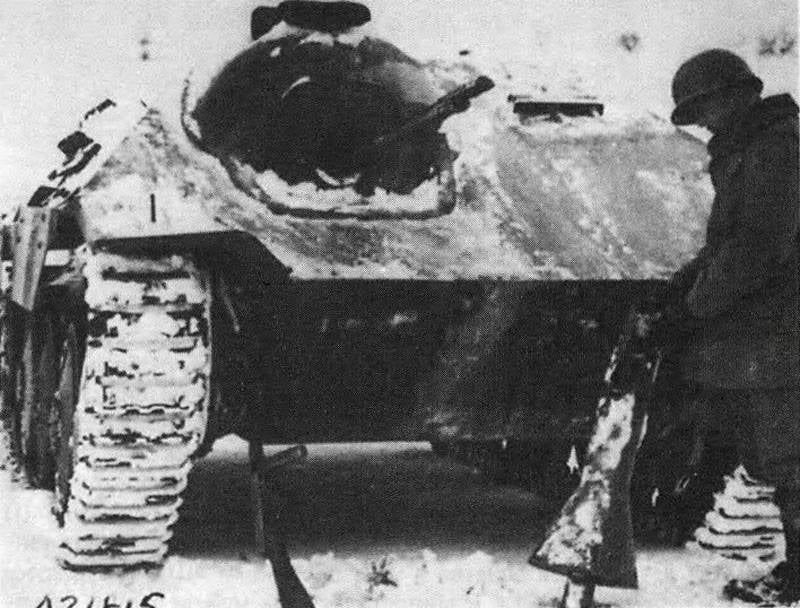
American soldiers are studying the captured car. With the hose removed the tubular casing. Photo of Chamberlain P., Doyle H. "Complete reference book of German tanks and self-propelled guns of the Second World War"
The use of new weapons did not lead to a reduction in crew. As in the case of the base ACS Jagdpanzer 38 (t), the flamethrower tank Flammpanzer 38 (t) was to be controlled by four crew members. In the right part of the body was placed the workplace of the commander. To the left of the weapons were placed the driver and the gunner. The absence of the need for constant supply of ammunition to the gun allowed the loader to leave only the duties of a radio operator. His place was placed in the back of the habitable compartment.
Despite all the improvements, the dimensions and weight characteristics of the flamethrower SAU remained at the level of the predecessor machine. The length of the Flammpanzer 38 (t) without armament was 4,87 m, width - 2,63 m, height - 2,17 m. The combat weight was determined at the level of 15,5 t. A slight decrease in combat weight in comparison with the base self-propelled movement had a positive effect on mobility. The maximum speed on the highway increased from 40 to 42 km / h, the power reserve remained at the level of 180 km. Thus, the flamethrower armored vehicle could work in the same combat formations with other equipment that was in service with Germany, and perform the assigned tasks of attacking various objects and manpower.
In December 1944, the company BMM assembled and transferred to the customer 20 flamethrower self-propelled guns of a new type. Soon, this technique was sent to the places of future battles in the Ardennes, where she had to participate in battles for the first time. Two dozen cars were part of the 352 and 353 tank armored flamethrowers. Unfortunately, there is no detailed information about the combat use of the Flammpanzer 38 self-propelled guns (t). There are only fragmentary data telling about the participation of such equipment in the battles on various fronts in Europe.
It is known that for the first time Flammpanzer 38 (t) took part in the battle during the Ardennes operation in December 1944 of the year - shortly after the transfer to the military. The use of such equipment in highly rugged terrain and in small settlements did not give noticeable results. Moreover, the beginning of the Allied offensive led to the fact that part of the German technology got them as trophies. Among other armored vehicles were captured and several new flamethrower self-propelled guns.
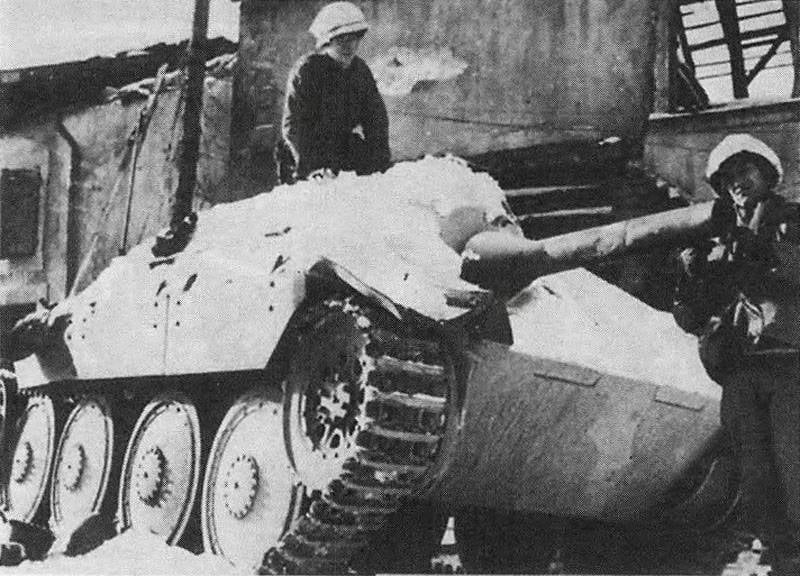
The study of the trophy. Photo of Chamberlain P., Doyle H. "Complete reference book of German tanks and self-propelled guns of the Second World War"
While retreating, the German troops took with them the remaining Flammpanzer 38 (t). In the future, an attempt was made to once again use this technique in offensive operations. The second and last case of the combat use of flamethrower tanks of this type refers to the Balaton operation in March 1945. Self-propelled flamethrowers were used to support the advancing infantry, but could not influence the course of the fighting. The advance of the German troops stopped, after which the Red Army counterattacked by launching the Vienna offensive.
Any information about the further operation of the machines Flammpanzer 38 (t) is missing. Perhaps in the battles of Fr. Balaton destroyed the last remaining machines, after which the operation of such equipment ceased, and the assembly of new self-propelled guns did not begin. As a result, 20 machines with flamethrowing weapons managed to take part in several battles, but could not leave a noticeable mark on stories.
The main reason for such failures can be considered the dubious fighting qualities of flame-throwing tanks of this appearance. They could effectively deal with manpower, unprotected equipment and some enemy installations, but in some cases there was a high risk of destruction from artillery or even from infantry anti-tank weapons. The presence of a flammable liquid on board the 700, not counting gasoline, led to increased fire hazards and could lead to fatal damage if the machine was hit by armor-piercing ammunition. At the same time, for shooting with a fire mixture, the self-propelled gun had to come close to the enemy, entering the zone of destruction of its anti-tank weapons.
After the war, ČKD attempted to develop the Flammpanzer 38 (t) project, which resulted in the appearance of the MP-1 armored vehicle. By reducing the crew to two people and freeing up additional volumes in the fighting compartment, it was possible to place 1000 and fire mixes. Such a flamethrower tank was tested in the 1951 year, but it did not suit the military. The main claim was insufficient range, no more than 60 m. To increase the range, it was proposed to use the composition of the mixture of Soviet development. A less heavy liquid could be thrown a distance to 140 m, however, the Czechoslovak military was not interested in this version of the car either. In 1955, the MP-1 project was closed, which led to a complete halt in the work on the Hetzer ACS reworking into flamethrowing tanks.
Based on:
http://achtungpanzer.com/
http://mg-tank.ru/
http://aviarmor.net/
http://lexikon-der-wehrmacht.de/
http://militaryfactory.com/
http://zonwar.ru/
http://historyofwar.org/
Chamberlain P., Doyle H. Complete reference book of German tanks and self-propelled guns of the Second World War. - M .: AST: Astrel, 2008.
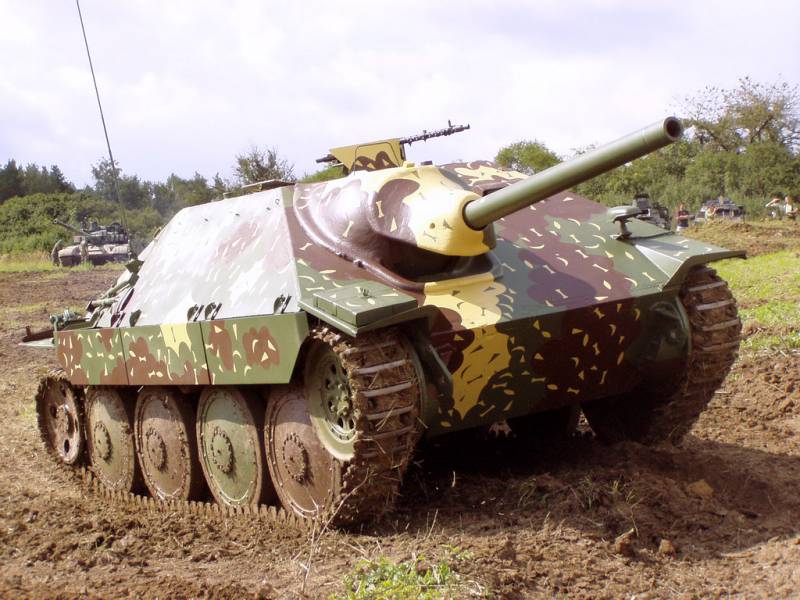
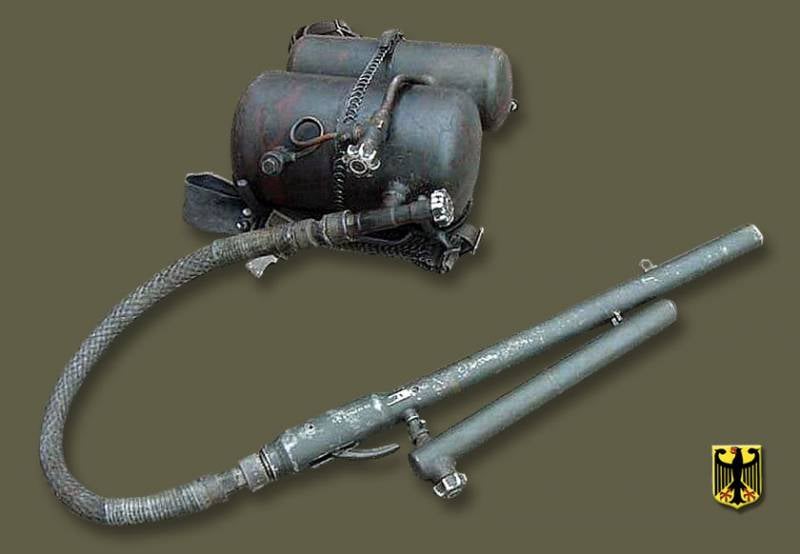
Information